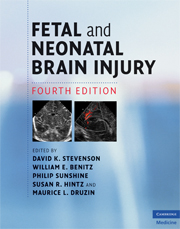Book contents
- Frontmatter
- Contents
- List of contributors
- Foreword
- Preface
- Section 1 Epidemiology, pathophysiology, and pathogenesis of fetal and neonatal brain injury
- Section 2 Pregnancy, labor, and delivery complications causing brain injury
- Section 3 Diagnosis of the infant with brain injury
- Section 4 Specific conditions associated with fetal and neonatal brain injury
- 22 Congenital malformations of the brain
- 23 Neurogenetic disorders of the brain
- 24 Hemorrhagic lesions of the central nervous system
- 25 Neonatal stroke
- 26 Hypoglycemia in the neonate
- 27 Hyperbilirubinemia and kernicterus
- 28 Polycythemia and fetal–maternal bleeding
- 29 Hydrops fetalis
- 30 Bacterial sepsis in the neonate
- 31 Neonatal bacterial meningitis
- 32 Neurological sequelae of congenital perinatal infection
- 33 Perinatal human immunodeficiency virus infection
- 34 Inborn errors of metabolism with features of hypoxic–ischemic encephalopathy
- 35 Acidosis and alkalosis
- 36 Meconium staining and the meconium aspiration syndrome
- 37 Persistent pulmonary hypertension of the newborn
- 38 Pediatric cardiac surgery: relevance to fetal and neonatal brain injury
- Section 5 Management of the depressed or neurologically dysfunctional neonate
- Section 6 Assessing outcome of the brain-injured infant
- Index
- Plate section
- References
34 - Inborn errors of metabolism with features of hypoxic–ischemic encephalopathy
from Section 4 - Specific conditions associated with fetal and neonatal brain injury
Published online by Cambridge University Press: 12 January 2010
- Frontmatter
- Contents
- List of contributors
- Foreword
- Preface
- Section 1 Epidemiology, pathophysiology, and pathogenesis of fetal and neonatal brain injury
- Section 2 Pregnancy, labor, and delivery complications causing brain injury
- Section 3 Diagnosis of the infant with brain injury
- Section 4 Specific conditions associated with fetal and neonatal brain injury
- 22 Congenital malformations of the brain
- 23 Neurogenetic disorders of the brain
- 24 Hemorrhagic lesions of the central nervous system
- 25 Neonatal stroke
- 26 Hypoglycemia in the neonate
- 27 Hyperbilirubinemia and kernicterus
- 28 Polycythemia and fetal–maternal bleeding
- 29 Hydrops fetalis
- 30 Bacterial sepsis in the neonate
- 31 Neonatal bacterial meningitis
- 32 Neurological sequelae of congenital perinatal infection
- 33 Perinatal human immunodeficiency virus infection
- 34 Inborn errors of metabolism with features of hypoxic–ischemic encephalopathy
- 35 Acidosis and alkalosis
- 36 Meconium staining and the meconium aspiration syndrome
- 37 Persistent pulmonary hypertension of the newborn
- 38 Pediatric cardiac surgery: relevance to fetal and neonatal brain injury
- Section 5 Management of the depressed or neurologically dysfunctional neonate
- Section 6 Assessing outcome of the brain-injured infant
- Index
- Plate section
- References
Summary
Introduction
Inborn errors of metabolism that present in the neonatal period can have clinical, biochemical, and neuroradiologic features similar to those of hypoxic–ischemic encephalopathy (HIE). Both metabolic disorders and HIE are associated with severe neurologic distress, metabolic acidosis, and multiorgan system involvement. Perinatal asphyxia affects 2–4/1000 neonates, with encephalopathy occurring in 25% and death in an additional 30%. In general, the patterns of brain injury are different when HIE and inborn errors of metabolism are compared. However, some metabolic disorders may have neuroradiologic findings similar to those seen in HIE. Inborn errors are rare individually, but as a group they affect approximately 1/1000 neonates. It is crucial to consider these disorders in the differential diagnosis of patients who present with non-specific features suggestive of sepsis or asphyxia. Prompt diagnosis not only may prevent mortality or significant morbidity, but also allows the clinician to provide the family with accurate genetic counseling. Although expanded newborn screening using tandem mass spectrometry (MS/MS) will detect a number of metabolic disorders, this testing will miss many inborn errors of metabolism that present with HIE-like features. In such cases, specialized testing is required in order to establish a diagnosis. In this chapter, patterns of brain injury and systemic complications that occur in HIE and metabolic disorders are reviewed. Specific inborn errors of metabolism with clinical presentations that may be seen in patients with HIE are discussed further.
- Type
- Chapter
- Information
- Fetal and Neonatal Brain Injury , pp. 389 - 401Publisher: Cambridge University PressPrint publication year: 2009



